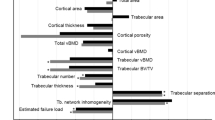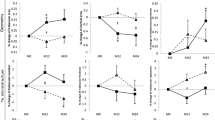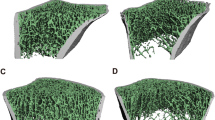Abstract
Summary
High-resolution peripheral quantitative computed tomography (HR-pQCT) analysis of female juvenile-onset systemic lupus erythematosus (JoSLE) patients revealed trabecular/cortical bone damage and reduced bone strength primarily at the distal radius compared to healthy controls. We demonstrated for the first time that JoSLE patients with vertebral fracture (VF) present trabecular impairment at the distal radius.
Introduction
This study investigated the volumetric bone mineral density (vBMD), microarchitecture, and biomechanical features at the distal radius and tibia using HR-pQCT and laboratory bone markers in JoSLE patients compared to controls to determine whether this method discriminates JoSLE patients with or without VF.
Methods
We compared 56 female JoSLE patients to age- and Tanner-matched healthy controls. HR-pQCT was performed at the distal radius and tibia. Serum levels of the amino-terminal pro-peptide of type I collagen, the C-terminal telopeptide of type I collagen, intact parathormone, sclerostin, and 25-hydroxyvitamin D (25OHD) were evaluated. VFs were analyzed using VFA-dual-energy X-ray absorptiometry (DXA) (Genant’s method).
Results
Reduced density and strength parameters and microarchitecture alterations of cortical and trabecular bones were observed in JoSLE patients compared to controls, primarily at the distal radius (p < 0.05). Patients with VF exhibited a significant decrease in trabecular bone parameters solely at the distal radius (Total.BMD, p = 0.034; Trabecular.BMD [Tb.BMD], p = 0.034; bone volume (BV)/trabecular volume (TV), p = 0.034; apparent modulus, p = 0.039) and higher scores for disease damage (Systemic Lupus International Collaborating Clinics/American College of Rheumatology Damage Index (SLICC/ACR-DI), p = 0.002). Bone metabolism markers were similar in all groups. Logistic regression analysis of parameters that were significant in univariate analysis revealed that Tb.BMD (OR 0.98, 95 % CI 0.95–0.99, p = 0.039) and SLICC/ACR-DI (OR 7.37, 95 % CI 1.75–30.97, p = 0.006) were independent risk factors for VF.
Conclusion
In conclusion, this study is the first demonstration of bone microstructure and strength deficits in JoSLE patients, particularly at the distal radius. Our results demonstrated that VF was associated with trabecular radius alteration and emphasized the potential detrimental effect of disease damage on this condition.
Similar content being viewed by others
References
Lee C, Ramsey-Goldman R (2005) Osteoporosis in systemic lupus erythematosus mechanisms. Rheum Clin North Am 31:363–385, viii
Burnham JM, Leonard MB (2004) Bone disease in pediatric rheumatologic disorders. Curr Rheumatol Rep 6(1):70–78, Review
Hernandez CJ, Beaupré GS, Carter DR (2003) A theoretical analysis of the relative influences of peak BMD, age-related bone loss and menopause on the development of osteoporosis. Osteopath Int 14:843–847
Boutroy S, Bouxsein ML, Munoz F, Delmas PD (2005) In vivo assessment of trabecular bone microarchitecture by high-resolution peripheral quantitative computed tomography. J Clin Endocrinol Metab 90:6508–6515
Santiago RA, Silva CA, Caparbo VF et al (2008) Bone mineral apparent density in juvenile dermatomyositis: the role of lean body mass and glucocorticoid use. Scand J Rheumatol 37(1):40–47
Tan EM, Cohen AS, Fries JF et al (1982) The 1982 revised criteria for the classification of systemic lupus erythematosus. Arthritis Rheum 25:1271–1277
Duke PM, Litt IF, Gross RT (1980) Adolescents’ self-assessment of sexual maturation. Pediatrics 66:918–920
Farias Junior JC, Lopes AS, Mota J et al (2012) Validity and reproductibility of a physical activity questionnaire for adolescents: adapting the self-administered physical activity checklist. Rev Bras Epidemiol 15:198–210
Ibanez D, Gladman DD, Urowitz MB (2005) Adjusted mean Systemic Lupus Erythematosus Disease Activity Index-2K is a predictor of outcome in SLE. J Rheumatol 32:824–827
Gladman D, Ginzler E, Goldsmith C et al (1996) The development and initial validation of the Systemic Lupus International Collaborating Clinics/American College of Rheumatology damage index for systemic lupus erythematosus. Arthritis Rheum 39:363–369
Domiciano DS, Figueiredo CP, Lopes JB et al (2013) Vertebral fracture assessment by dual X-ray absorptiometry: a valid tool to detect vertebral fractures in community-dwelling older adults in a population-based survey. Arthritis Care Res 65(5):809–815
Seguro LP, Casella CB, Caparbo VF et al (2015) Lower P1NP serum levels: a predictive marker of bone loss after 1 year follow-up in premenopausal systemic lupus erythematosus patients. Osteoporos Int 26(2):459–467
Genant HK, Wu CY, van Kuijk C, Nevitt MC (1993) Vertebral fracture assessment using a semiquantitative method. J Bone Miner Res 8:1137–1148
Siminoski K, Lee KC, Jen H et al. (2012) Anatomical distribution of vertebral fractures: a comparison of pediatric and adult spine STOPP Consortium. Osteoporos Int 23(7): 1999–2008.
Fuller H, Fuller R, Pereira RMR (2015) High resolution peripheral quantitative computed tomography (HR-pQCT) for the assessment of morphological and mechanical bone parameters. Rev Bras Reumatol 55(4):352–362
Burrows M, Liu D, Perdios A et al (2010) Assessing bone microstructure at the distal radius in children and adolescents using HR-pQCT: a methodological pilot study. J Clin Densitom 13(4):451–455
Burghardt AJ, Pialat JB, Kazakia GJ et al (2013) Multicenter precision of cortical and trabecular bone quality measures assessed by high-resolution peripheral quantitative computed tomography. J Bone Miner Res 28(3):524–536
Saad CG, Ribeiro AC, Moraes JC et al (2012) Low sclerostin levels: a predictive marker of persistent inflammation in ankylosing spondylitis during anti-tumor necrosis factor therapy? Arthritis Res Ther 14(5):R216
Tang XL, Griffith JF, Qin L et al (2013) SLE disease per se contributes to deterioration in bone mineral density, microstructure and bone strength. Lupus 22(11):1162–1168
Kirmani S, Christen D, van Lenthe GH et al (2009) Bone structure at the distal radius during adolescent growth. J Bone Miner Res 24(6):1033–1042
Beerhorst K, Tan IY, De Krom M et al (2013) Antiepileptic drugs and high prevalence of low bone mineral density in a group of inpatients with chronic epilepsy. Acta Neurol Scand 128(4):273–280
Arya V, Bhambri R, Godbole MM, Mithal A (2004) Vitamin D status and its relationship with bone mineral density in healthy Asian Indians. Osteoporos Int 15(1):56–61
Sasimontonkul S, Bay BK, Pavol MJ (2007) Bone contact forces on the distal tibia during the stance phase of running. J Biomech 40(15):3503–3509
Wehner T, Claes L, Simon U (2009) Internal loads in the human tibia during gait. Clin Biomech (Bristol, Avon) 24(3):299–302
Burr BD, Matrtin RB (1983) The effects of composition, structure and age on the torsional properties of the human radius. J Biomech 16:603–608
Paggiosi MA, Eastell R, Walsh JS (2014) Precision of high-resolution peripheral quantitative computed tomography measurement variables: influence of gender, examination site, and age. Calcif Tissue Int 94(2):191–201
Regio P, Bonfá E, Takayama L, Pereira RM (2008) The influence of lean mass in trabecular and cortical bone in juvenile onset systemic lupus erythematosus. Lupus 17:787–792
Borba VZ, Matos PG, da Silva Viana PR et al (2005) High prevalence of vertebral deformity in premenopausal systemic lupus erythematosus patients. Lupus 14(7):529–533
Almehed K, Hetényi S, Ohlsson C et al (2010) Prevalence and risk factors of vertebral compression fractures in female SLE patients. Arthritis Res Ther 12(4):R153
LeBlanc CM, Ma J, Taljaard M et al (2015) Canadian STeroid-associated osteoporosis in the pediatric population (STOPP) consortium. Incident vertebral fractures and risk factors in the first three years following glucocorticoid initiation among pediatric patients with rheumatic disorders. J Bone Miner Res 30(9):1667–1675
Rodd C, Lang B, Ramsay T et al (2012) Canadian Steroid-Associated Osteoporosis in the Pediatric Population (STOPP) Consortium. Incident vertebral fractures among children with rheumatic disorders 12 months after glucocorticoid initiation: a national observational study. Arthritis Care Res 64(1):122–131
Huber AM, Gaboury I, Cabral DA et al (2010) Canadian steroid-associated osteoporosis in the pediatric population (STOPP) consortium. Prevalent vertebral fractures among children initiating glucocorticoid therapy for the treatment of rheumatic disorders. Arthritis Care Res 62(4):516–526
Rouster-Stevens KA, Klein-Gitelman MS (2005) Bone health in pediatric rheumatic disease. Curr Opin Pediatr 17:703–708
Viswanathan A, Sylvester FA (2008) Chronic pediatric inflammatory diseases: effects on bone. Rev Endocr Metab Disord 9:107–122
Bultink IEM (2012) Osteoporosis and fractures in systemic lupus erythematosus. Arthritis Care Res 64(1):2–8
Tang XL, Qin L, Kwok AW et al (2013) Alterations of bone geometry, density, microarchitecture, and biomechanical properties in systemic lupus erythematosus on long-term glucocorticoid: a case–control study using HR-pQCT. Osteoporos Int 24(6):1817–1826
Bultink IE, Lems WF, Kostense PJ et al (2005) Prevalence of and risk factors for low bone mineral density and vertebral fractures in patients with systemic lupus erythematosus. Arthritis Rheum 52(7):2044–2050
Kalla AA, Fataar AB, Jessop SJ, Bewerunge L (1993) Loss of trabecular bone mineral density in systemic lupus erythematosus. Arthritis Rheum 36:1726–1734
Yee CS, Crabtree N, Skan J et al (2005) Prevalence and predictors of fragility fractures in systemic lupus erythematosus. Ann Rheum Dis 64(1):111–113
Vasikaran S, Eastell R, Bruyère O et al. (2011) IOF-IFCC Bone Marker Standards Working Group. Markers of bone turnover for the prediction of fracture risk and monitoring of osteoporosis treatment: a need for international reference standards. Osteoporos Int 22(2): 391–420.
Bhattoa HP, Bettembuk P, Balogh A et al (2004) The effect of 1-year transdermal estrogen replacement therapy on bone mineral density and biochemical markers of bone turnover in osteopenic postmenopausal systemic lupus erythematosus patients: a randomized, double-blind, placebo-controlled trial. Osteoporos Int 15(5):396–404
Tang XL, Zhu TY, Hung VW et al (2012) Increased organ damage associated with deterioration in volumetric bone density and bone microarchitecture in patients with systemic lupus erythematosus on longterm glucocorticoid therapy. J Rheumatol 39(10):1955–1963
Dhillon VB, Davies MC, Hall ML et al (1990) Assessment of the effect of oral corticosteroids on bone mineral density in systemic lupus erythematosus: a preliminary study with dual energy x ray absorptiometry. Ann Rheum Dis 49(8):624–626
Hansen M, Halberg P, Kollerup G et al (1998) Bone metabolism in patients with systemic lupus erythematosus: effect of disease activity and glucocorticoid treatment. Scand J Rheumatol 27(3):197–206
Pineau CA, Urowitz MB, Fortin PJ et al (2004) Osteoporosis in systemic lupus erythematosus: factors associated with referral for bone mineral density studies, prevalence of osteoporosis and factors associated with reduced bone density. Lupus 13(6):436–441
Acknowledgments
We thank Prof J. M. Burnham, Pediatric Rheumatology, The Children’s Hospital of Philadelphia, University of Philadelphia, USA for revising the paper and Rogerio Ruscuitto, PhD for the statistical analysis.
Author information
Authors and Affiliations
Corresponding author
Ethics declarations
The Local Ethics Committee approved the study, and written informed consent was obtained from all participants or their legal guardians.
Conflicts of interest
None.
Funding statement
This study was supported by grants from the Conselho Nacional de Desenvolvimento Científico e Tecnológico (CNPQ #472754/2013-0), individual grants (CNPQ #301805/2013-0 to RMRP and #301411/2009-3 to EB) and Federico Foundation grants (to RMRP and EB).
Rights and permissions
About this article
Cite this article
Paupitz, J.A., Lima, G.L., Alvarenga, J.C. et al. Bone impairment assessed by HR-pQCT in juvenile-onset systemic lupus erythematosus. Osteoporos Int 27, 1839–1848 (2016). https://doi.org/10.1007/s00198-015-3461-y
Received:
Accepted:
Published:
Issue Date:
DOI: https://doi.org/10.1007/s00198-015-3461-y




